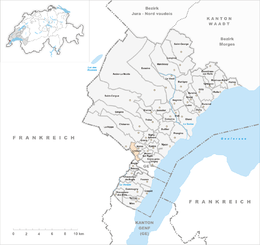Crassier (Vaud)
| Crassier | ||
|---|---|---|
 |
||
|
||
| Coordinates: 46°22′N 6°10′E / 46.367°N 6.167°ECoordinates: 46°22′N 6°10′E / 46.367°N 6.167°E | ||
| Country | Switzerland | |
| Canton | Vaud | |
| District | Nyon | |
| Government | ||
| • Mayor | Syndic | |
| Area | ||
| • Total | 2.03 km2 (0.78 sq mi) | |
| Elevation | 475 m (1,558 ft) | |
| Population (Dec 2016) | ||
| • Total | 1,201 | |
| • Density | 590/km2 (1,500/sq mi) | |
| Postal code | 1263 | |
| SFOS number | 5714 | |
| Surrounded by | Arnex-sur-Nyon, Bogis-Bossey, Borex, Céligny (GE), Chéserex, Crans-près-Céligny, Divonne-les-Bains (FR-01), La Rippe | |
| Website |
www Profile (in French), SFSO statistics |
|
Crassier is a municipality in the district of Nyon in the canton of Vaud in Switzerland.
Crassier is first mentioned in 1123 as de Craceio.
Crassier has an area, as of 2009[update], of 2 square kilometers (0.77 sq mi). Of this area, 1.39 km2 (0.54 sq mi) or 68.5% is used for agricultural purposes, while 0.22 km2 (0.085 sq mi) or 10.8% is forested. Of the rest of the land, 0.43 km2 (0.17 sq mi) or 21.2% is settled (buildings or roads).
Of the built up area, industrial buildings made up 2.0% of the total area while housing and buildings made up 12.8% and transportation infrastructure made up 4.4%. Power and water infrastructure as well as other special developed areas made up 1.5% of the area Out of the forested land, 8.9% of the total land area is heavily forested and 2.0% is covered with orchards or small clusters of trees. Of the agricultural land, 62.6% is used for growing crops, while 4.9% is used for orchards or vine crops.
The municipality was part of the Nyon District until it was dissolved on 31 August 2006, and Crassier became part of the new district of Nyon.
The municipality is located near the French border on the Nyon-Divonne road.
The blazon of the municipal coat of arms is Gules, a Bar wavy Argent, overall two Keys saltirewise Or, in base a Coupeaux of the last.
Crassier has a population (as of December 2016[update]) of 1,201. As of 2008[update], 27.2% of the population are resident foreign nationals. Over the last 10 years (1999–2009 ) the population has changed at a rate of 50.9%. It has changed at a rate of 39.3% due to migration and at a rate of 13.7% due to births and deaths.
...
Wikipedia




